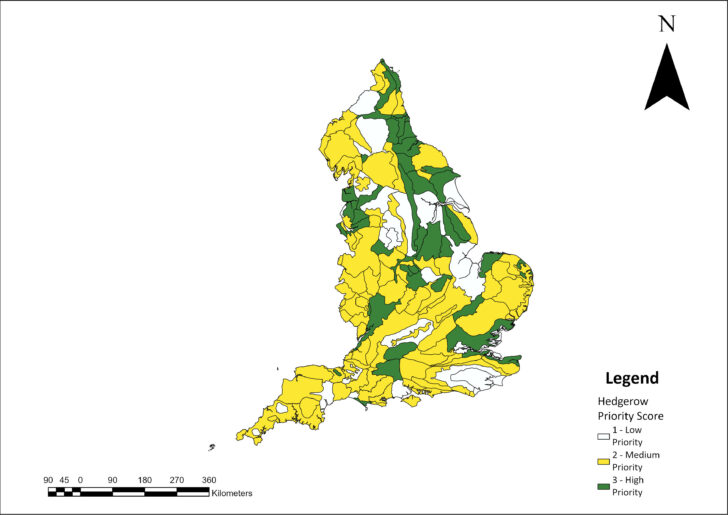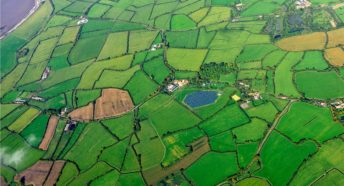Where should we plant and restore hedgerows? Our hedgerow report explained
The Organic Research Centre report ‘Aiming high for hedgerows’ (commissioned by CPRE) was published during National Hedgerow Week 2024, and features an in-depth study looking at how we can best deliver Defra’s hedgerow targets.
Hedgerows are the unsung heroes of our countryside. Not only are they embedded in our national heritage, but they provide enormous benefits to our environment. We refer to the benefits of habitats and ecosystems to humanity as ‘ecosystem services’, and hedgerows provide a lot of them. They help regulate our climate by absorbing carbon dioxide, provide a home for wildlife, help regulate and filter water flows, and encourage pollination and natural pest predators.
CPRE has been campaigning on behalf of hedgerows for many years (winning an award for our campaign in 2023), and almost 50,000 CPRE supporters signed a petition to push for ambitious hedgerow targets, which were finally announced in 2023. But now that we have a target, the key questions are: where should these hedgerows go, and where should we focus our restoration efforts? Our report with the ORC aims to answer these very questions.
How the report was put together
England’s ‘National Character Areas’ (NCAs) were used as the basis of the study, which are areas across the country that have distinct characteristics, such as soil type, flora and fauna, landscape type and geology. There are 159 NCAs in England, and examples include the Lincolnshire Wolds, known for its chalky grasslands and farmland and the Yorkshire Dales, which features lots of grazed upland and hilly landscapes.
Using NCAs is ideal because it means we can make recommendations based on the specific environmental contexts of each area. This information can provide a framework to best ensure hedgerow planting and restoration happens both where it is needed, and where conditions are most suitable.
Each NCA was analysed and given a score between 1 and 3, based on three distinct criteria, which were:
- How intact the historic hedgerow network was (in other words, whether hedgerows have been lost in the area, and if some hedges have been planted or restored since)
- The condition of existing hedgerows (for example are they well-maintained, tall and bushy – or gappy with few flowers)
- Policy support for hedgerows (how many hedgerows are supported through farming subsidies or statements of environmental opportunity)
Using this criterion, a score of 1 refers to ‘low priority’ for hedgerow action, 2 is ‘medium’ and 3 is ‘high’ priority.
Key findings: hedgerow loss, condition and policy support
The research found that a fifth of all NCAs had historically high levels of hedgerow cover which has since been lost and not sufficiently replaced. Notably, only a third of all NCAs had retained their historic levels of hedgerow cover, which confirms the significant level of hedgerow loss we’ve seen in England – particularly mature and ancient hedgerows.
In terms of hedgerow condition, almost 30% of all NCAs have hedgerows in a poor condition, with 50% in ‘medium’ condition, and just 20% in good condition. Hedgerow condition is a major driver in how well a hedgerow can support many ecosystem services, and so looking at the NCAs with the poorest condition hedgerows is a priority in considering where restoration should happen.
The research found that most NCAs (92%) had ‘Statements of Environmental Opportunity’ (SEOs) or related Countryside Stewardship ‘Statements of Priority’ that included a mention of hedgerows, signifying that there is some policy support for hedgerow planting and restoration in most landscapes. SEOs essentially help provide targeted guidance to support environmental restoration.

Hedgerow action
When taking into account all three criteria, the research reveals that 40 (25%) of all NCAs are classed as high priority for hedgerow action. The largest of these is the Northern Thames Basin, which stretches between Hertfordshire and Essex and has an area of more than 250,000 hectares. The top three priority urban areas for hedgerow action (i.e. areas with the highest % of urban land) are the Tyne and Wear Lowlands, Lancashire Coal Measures and the Northern Thames Basin.
Over half of all NCAs were classed as medium priority for hedgerow action, and 21% are considered lower priority (meaning there’s little scope for an extensive and healthy hedgerow network in these areas). The lowest scores in this regard include the Humberhead Levels in Yorkshire (which has a majority of fields bounded by ditches) and the Southern Pennines between the Peak District and Yorkshire Dales, where there’s a prevalence of dry stone walls.
Farming and hedgerows
Many of our hedgerows form linear habitats on the margins of farmland, and can contribute a huge amount of environmental benefit to farmers. From stabilising soils to providing natural stock-proof fencing and encouraging both pollination and natural pest controls, healthy hedgerows are a farmer’s friend, indeed. However, management is key to the future of hedgerows and their successful restoration.
In a majority of NCAs, less than 20% of hedgerows were under Environmental Stewardship (ES) or Countryside Stewardship (CS) schemes. This finding links closely with the condition report, with around 20% of hedgerows in NCAs in good condition. ES and CS schemes are put in place to reward farmers for managing their hedgerows for nature and climate, and include criteria like cutting frequency, timing and intensity. NCAs where a greater amount of hedgerows are under ES or CS schemes carry great potential in terms of planting, because they’re most likely to be managed in the best way.
Restoring hedgerows to meet the ambitions of the Defra targets is no mean feat; it will require upwards of £735 million in funding, and a lot of effort. Our research uses a specific example to demonstrate: in the South Norfolk and High Suffolk Claylands, it would require upwards of over 20,000 days of labour and millions in funding to restore, gap up, lay and plant hedgerows to meet the Defra targets.
Case studies
The report also includes six case studies in distinct areas across England, to get a more in-depth understanding of the local picture and the efforts underway to restore and plant hedgerows in these areas. For example, we found that in the South Hampshire Lowlands, which has low existing hedgerow cover, volunteers have mobilised to plant more than 5km of hedgerow between 2023-4. In the South Suffolk and North Essex Clayland (a medium priority for hedgerow action) over 10km of hedgerow has been restored, planted or coppiced.
Read more about the case studies in our summary report.
Our recommendations for hedgerows
Delivery of the hedgerow target in the Environmental Improvement Plan is both a challenge and an opportunity to create a brighter future for England’s hedgerows. The research has revealed where hedgerow action could be prioritised around the country, which includes 25% of NCAs which scored highest for priority. These indicative hedgerow targets at NCA level offer a framework for government to identify how and where the hedgerow targets can be best achieved. Based on the findings of the research, we make these recommendations to help ensure the achievement of the national hedgerow targets:
Government should:
- Target where action is needed to best deliver the national hedgerow targets in Defra’s promised national land use framework. Use this report, and others (including the updated Countryside Survey) to make informed decisions on hedgerow restoration.
- Develop a system for monitoring progress towards the 2037 and 2050 hedgerow targets, including quality as well as quantity of delivery. Ongoing management plans are critical.
- Make access to government funding opportunities as straightforward as possible to ensure a high uptake of these offers.
- Address continuing systemic threats to hedgerows to mitigate and remove ongoing biological, ecological and cultural barriers to achieving Favourable Conservation Status of England’s hedgerow network.
At the local level:
- Use this indicative target setting approach to initiate discussion with local stakeholders on local ambition for hedgerows and the means to finely tune the prioritisation of hedgerow action, including through emerging Local Nature Recovery Strategies.
- Encourage collaborative approaches (for example through farm clusters) that reduce costs of hedgerow action and increase access to grant funding.
- Continue to raise awareness of the many values of hedgerows to urban and rural populations. While the value of hedgerows depends on local contexts, encouraging awareness of the enormous benefits hedgerows can provide can influence hedgerow action.
- Design the right hedge for the right situation, considering wildlife composition and the structure needed to meet local needs and address climate change.
Read our report
You can read a summary version of the report here, or read the full report here. If you want to take action for hedgerows in your local area, you can get in touch with your local CPRE group and see what opportunities are available. Our continued Hedgerow Heroes project has seen hundreds of miles of hedgerow planted by volunteers across England, and with your support, we can do even more.






